
A PMflex-based software solution for Germany's Federal Ministry for Digital and State Modernization (BMDS): Hackathon insights and outlook
What does a software solution look like that enables employees in the German federal administration to successfully prioritize, manage, implement, and report on strategic initiatives?
At OpenProject, we had the chance to explore this very question during a hackathon last week, as we are on the shortlist for this software solution. In this article, we will present the exact requirements from the German Federal Ministry for Digital and Modernization of the State (BMDS) and the results we were able to deliver.
The requirements defined by the BMDS are based on PMflex, a comprehensive strategic management solution and integrated project management system developed at the federal level specifically for public administration. PMflex is based on the open source project management methodology PM² provided by the European Commission.
If you already want to “spoil” the results, feel free to watch the following video (available in German only), which we presented to the ministry at the end of the hackathon:
Este vídeo está actualmente disponible solo en alemán.
Article navigation:
- Wanted: A software solution for the strategic implementation of federal digitalization initiatives
- Delivered: Full commitment for ten new features and implementation in PMflexONE
- Found? – What happens after the hackathon?
Wanted: A software solution for the strategic implementation of federal digitalization initiatives
During the week of July 14–18, 2025, OpenProject not only released a new software version but also spontaneously participated in a kind of hackathon. The client was the Federal Ministry for Digital and Modernization of the State (BMDS). The ministry is looking for a software solution to implement strategies at the portfolio, program, and project levels.
We at OpenProject are honored to be shortlisted for this solution and used the hackathon to show that all requirements are either already met or will be met in the near future.
Transparency is one of our core values, so in this article we want to share an overview of the hackathon, the requirements, and of course our proposed solutions.
Requirements included:
- PMflex compatibility (tailoring)
- Consistency across portfolio, program, and project levels
- Cross-agency collaboration
- Agility
- Enjoyable user experience
Challenges for us:
- Only one week to develop additional features, comprehensive demo material, documentation, and (video) presentation. All of this alongside our daily business, including the release of version 16.2.
- Immersing ourselves in the working environment and various user stories from public administration, which operates very differently than we do internally. Here, our extensive experience with the public sector, especially in connection with openDesk, was a major advantage.
Overview of the required user stories:
Several user stories were provided, each with associated data like budget, status, target states, and more. Every user story included at least one fictional persona, from whose perspective the solution needed to be demonstrated.
- Prioritize portfolio elements
- Manage portfolio
- Report program status
- Report project status
In addition to the predefined user stories, we also showcased how the solution could be used on the go via the mobile app.
Delivered: Full commitment for ten new features and implementation in PMflexONE
Alongside 19 developers, many other OpenProject team members were fully engaged in the BMDS hackathon. Despite — or perhaps because of — the short timeframe and complex requirements, the energy and team spirit were tangible across all days, even across our globally distributed remote workspaces.
For Rosanna Sibora, who had her very first week at OpenProject as Chief Product Officer during the hackathon, the team’s commitment, creativity, and passion made a strong impression:
“During the hackathon, I was impressed by how well the self-organized teams collaborated. It clearly showed me how well-aligned the OpenProject team is and how open and empowering the culture is. We proved that 2+2 is definitely more than 4 — and what can be achieved with great collaboration and empowerment.” – Rosanna Sibora, CPO, OpenProject GmbH
OpenProject implementation – behind the scenes:
- Full energy and passion, not just from developers
- 15,000+ lines of new code
- Team formation for developing new features, building a demo instance, and designing product mockups for additional features
- Daily hackathon stand-ups, retros, and pulse checks with the BMDS and other stakeholders, 100% remote collaboration using other open source tools like Big Blue Button and Element
- Daily operations continued in parallel: support and release of OpenProject 16.2
OpenProject implementation – on the product level:
While the current version of OpenProject already supports the majority of requirements, we identified several aspects we wanted to expand or develop from scratch during the hackathon week. Especially relevant across all user stories was the development of features for reporting and managing goals, risks, and budgets.
Here is an overview of our main development focuses during the hackathon:
- Planning and managing portfolios and programs
- Enhancing portfolio and program dashboards
- Portfolio management with proposal functionality
- Linking and improved display of budget planning and overviews
- Calculated project scoring
- Risk management and overview
- Create status report meetings
- Documents module with real-time editing
- Mobile app enhancements for portfolio/program management
- AI foundations and support for documents and project/portfolio management
Let’s take a closer look at what these features and requirement implementations looked like by the end of the hackathon week.
Importante
Please note that this is a summary of key developments. Additional features were also planned, designed, and developed during the hackathon. As these features were created in a very short time, they are not yet fully tested or finalized.
Planning and managing portfolios and programs
To support PMflex, OpenProject needed to manage not just projects but also portfolios and programs. Modeling these was the first step during the hackathon. Portfolio, sub-portfolio, and program extend the existing project hierarchy with the ability to group projects and manage them collectively.
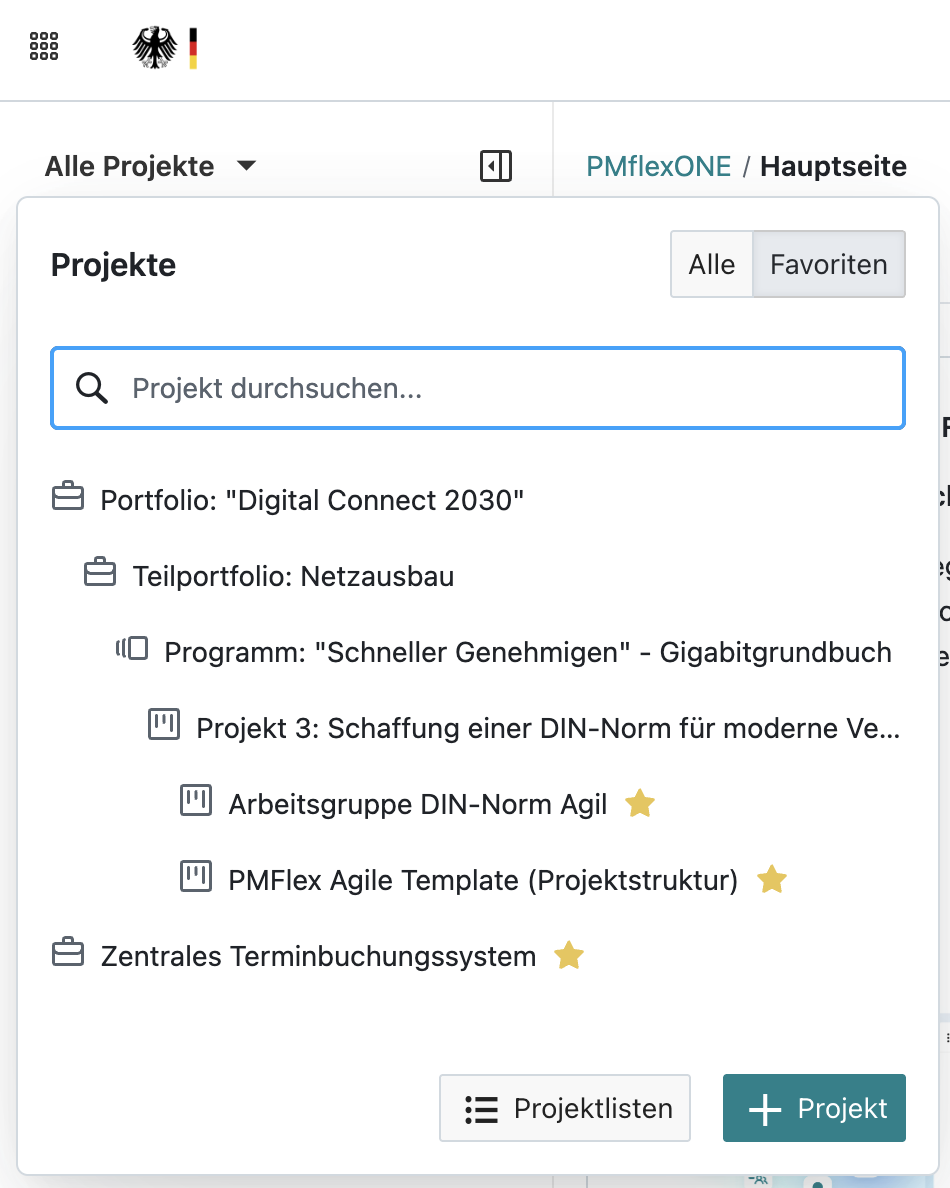
Enhancing portfolio and program dashboards
On the overview pages for portfolios, (sub-)programs, or even projects, managers want to see key information about goals, milestones, risks, and budgets at a glance. To enable this, we created widgets during the hackathon that visually aggregate this data: charts for budgets and risks, listings of components with their priority, status, and goal progress. These widgets were implemented as prototypes in a new dashboard using the OpenProject Design System.
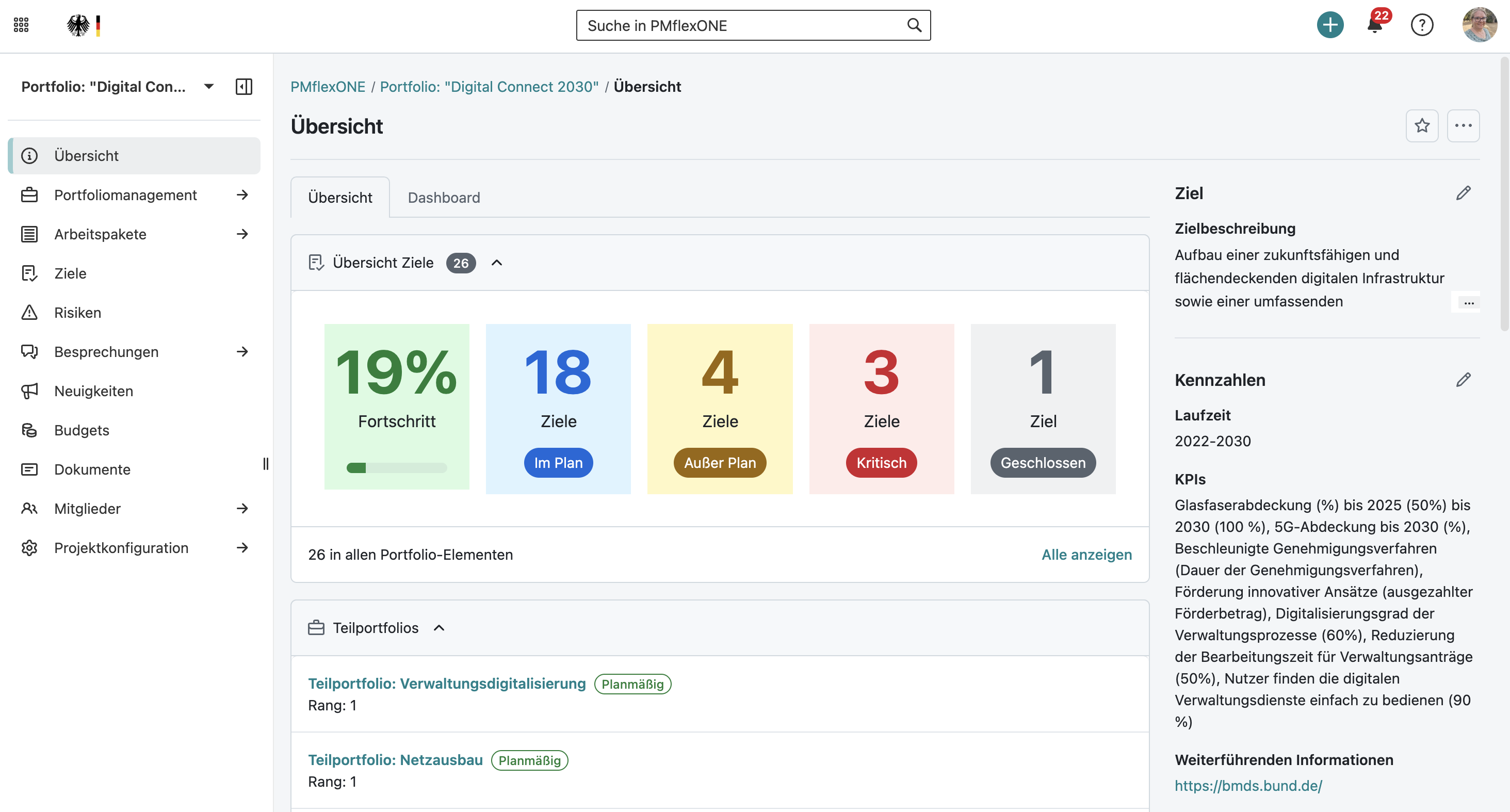
Portfolio management with proposal functionality
We created a dedicated module for portfolio management where managers can first create portfolio proposals and then submit them for review. These can be downloaded as PDFs or added to a meeting.
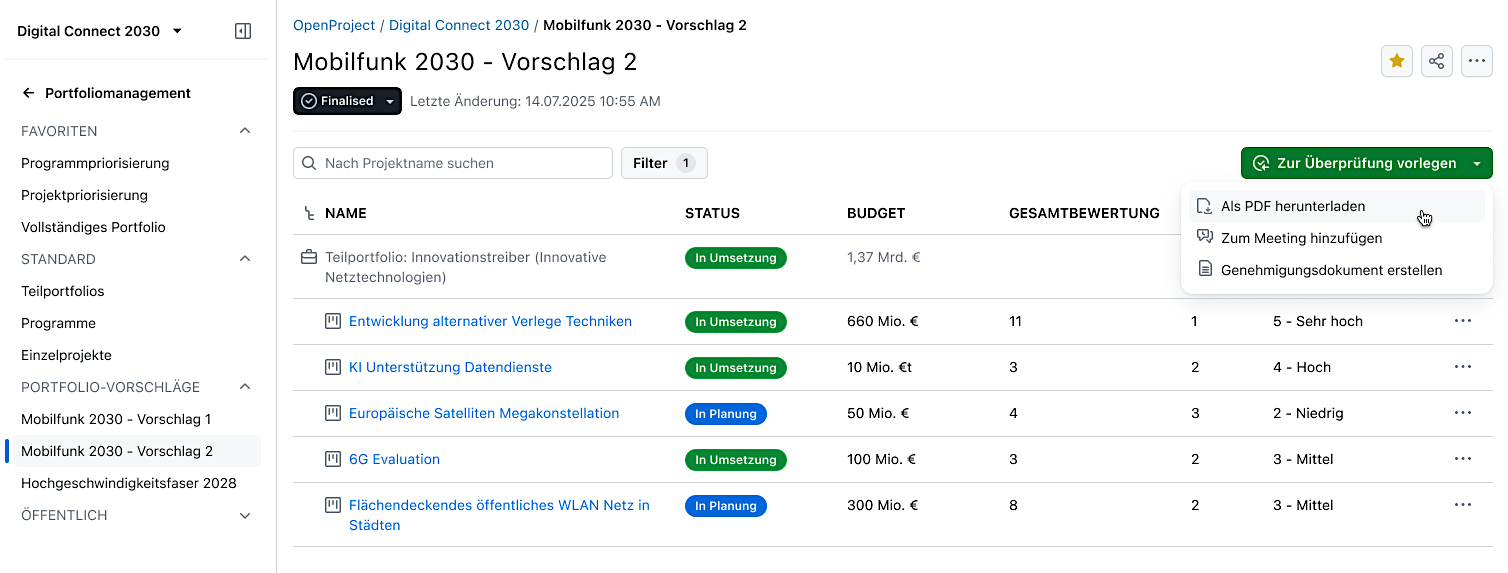
Linking and improved display of budget planning and overviews
OpenProject already supports extensive budgeting and cost tracking, but previously limited this to individual projects. During the hackathon, we added cross-project budgeting, distinctions between planned and booked costs, and modeling of sub-budgets. The overview page and project lists can now display total budgets and their components.

Calculated project scoring
Portfolio managers want to calculate project scores automatically based on project attributes, allowing better evaluation, prioritization, and communication of decisions. This functionality was further developed during the hackathon and activated on the demo instance to display ranking values for project weighting.
It is now possible to apply formulas to freely configurable values that together generate a score. This increases transparency and comparability of evaluations.
This feature is still in development (thanks City of Cologne for their support here), so we’re showing a design draft here:
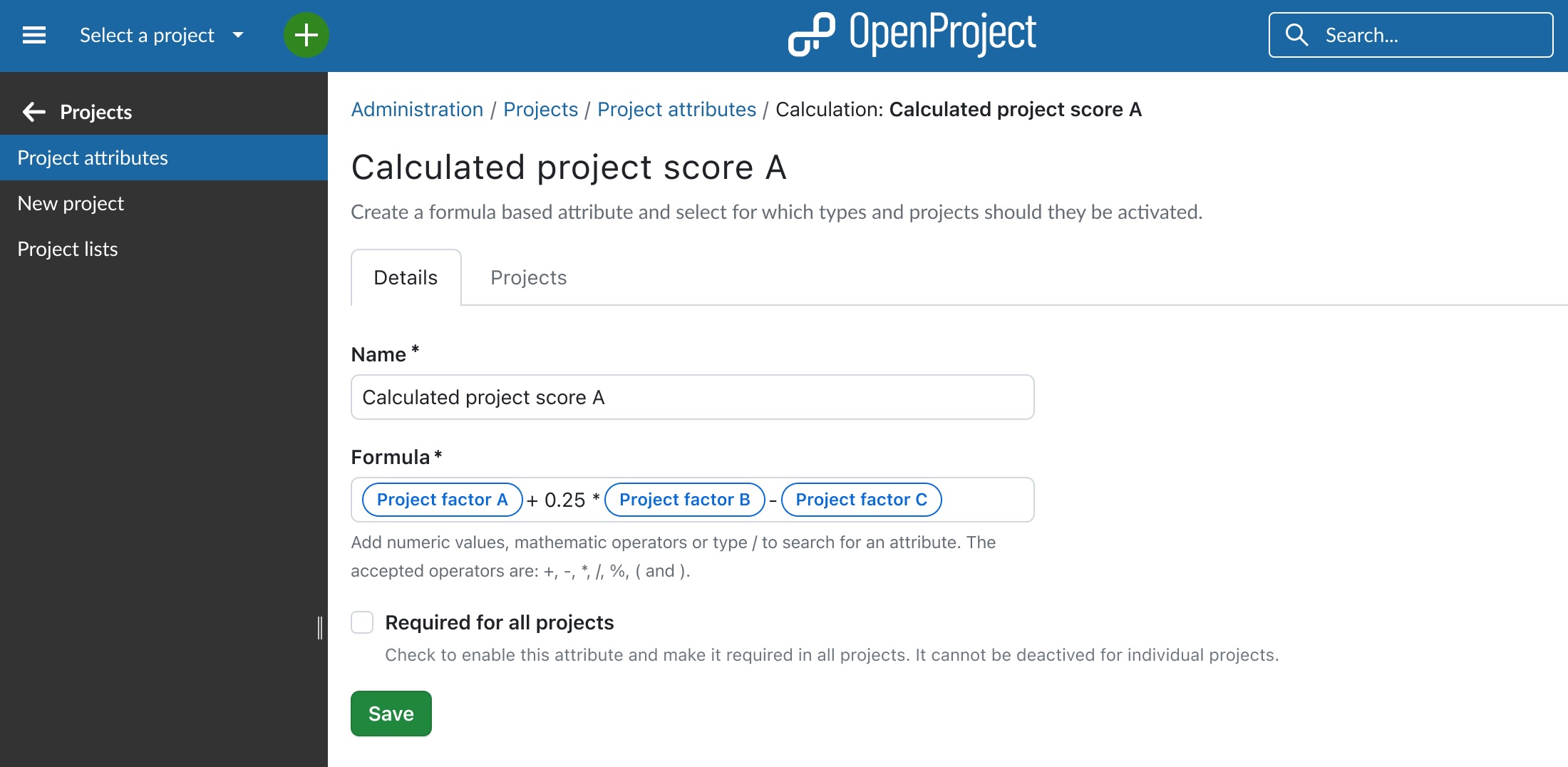
Risk management and overview
Since risk management is a core requirement for the BMDS, we created a dedicated risk module. It includes a risk matrix that visualizes project, portfolio, or program risks with color-coded severity.
Modeling is based on probability (1–5) and impact (1–5). The system calculates a risk level from these values.
This also means: Risks now have their own data type and are a core part of OpenProject. Users are encouraged to document risks, monitor them regularly, and take countermeasures.
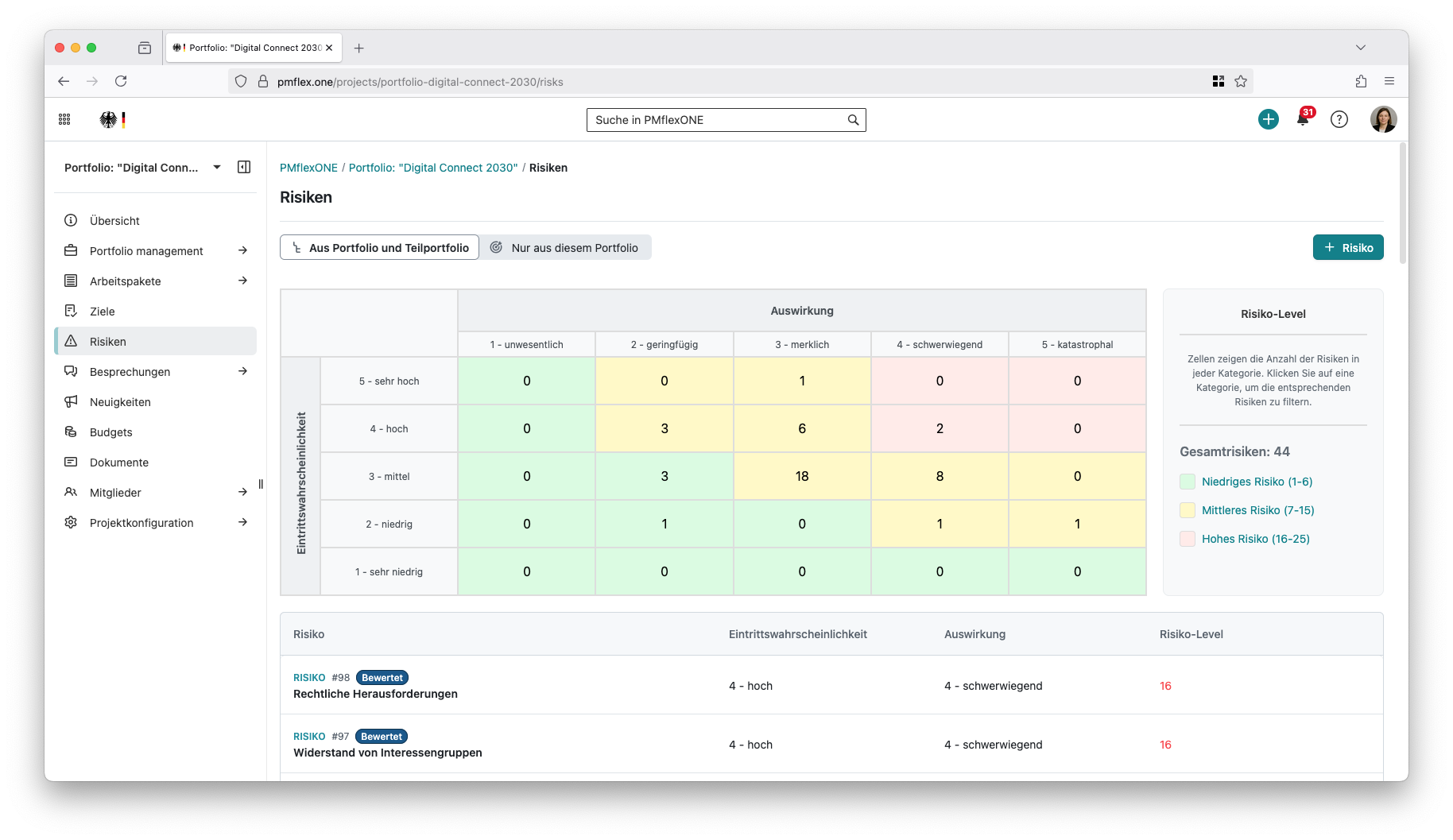
Create status report meetings
Status reports are a key element of PMflex. But they are not just documents — they are often discussed in meetings. That’s why we created a feature to automatically generate status report meetings.
Directly from the overview page, managers can create proposals for a status report meeting with the steering committee. They can select a baseline timeframe and add currently relevant information from the portfolio. The system generates an agenda based on selected changes for further editing.
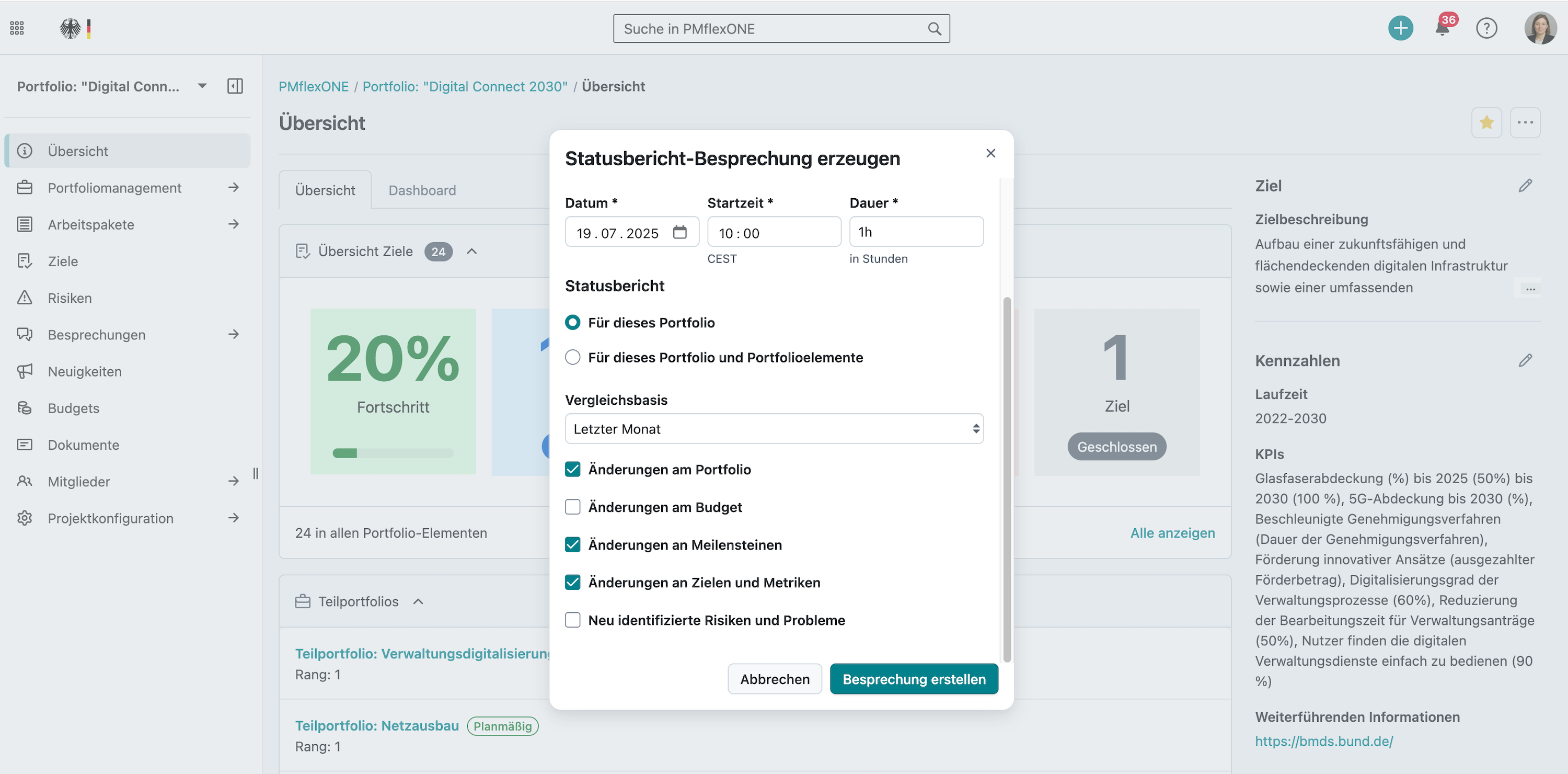
Documents module with real-time editing
A few weeks ago, OpenProject successfully participated in Hack Days 2025 in Paris, organized by the French government’s digital directorate, DINUM (direction interministérielle du numérique). We’ve now extended those features to enable collaborative real-time editing for multiple users.
To support collaborative creation and sharing of typical PMflex documents, the OpenProject documents module was completely redesigned. It now allows for automatically updated content and real-time collaborative editing.
Mobile app enhancements for portfolio/program management
We have been working on a mobile app (iOS/Android) for OpenProject for some time. During the hackathon, we also developed new functionality to differentiate between portfolio, program, and project levels in the app.
Please note that developing a high-quality mobile app takes time, and we want to ensure the best experience before release. Of course, we will announce availability as soon as it’s ready for users.
AI foundations and support for documents and project/portfolio management
OpenProject was extended with two core services: Haystack to gather relevant information, and a custom LLM (Large Language Model). Both services operate within the same network as OpenProject and have no internet access. No data leaves the cluster for AI usage.
Detailed AI features developed during the hackathon include:
AI-generated status report drafts
- Create drafts of status reports based on work packages and attributes visible to the respective user, using a local AI trained on PMflex
AI assistance in project and portfolio management
- Display of PMflex-based best practices on the overview page, based on analysis of project data and work packages
- A secure local AI assists with introducing best practices and provides timely management recommendations
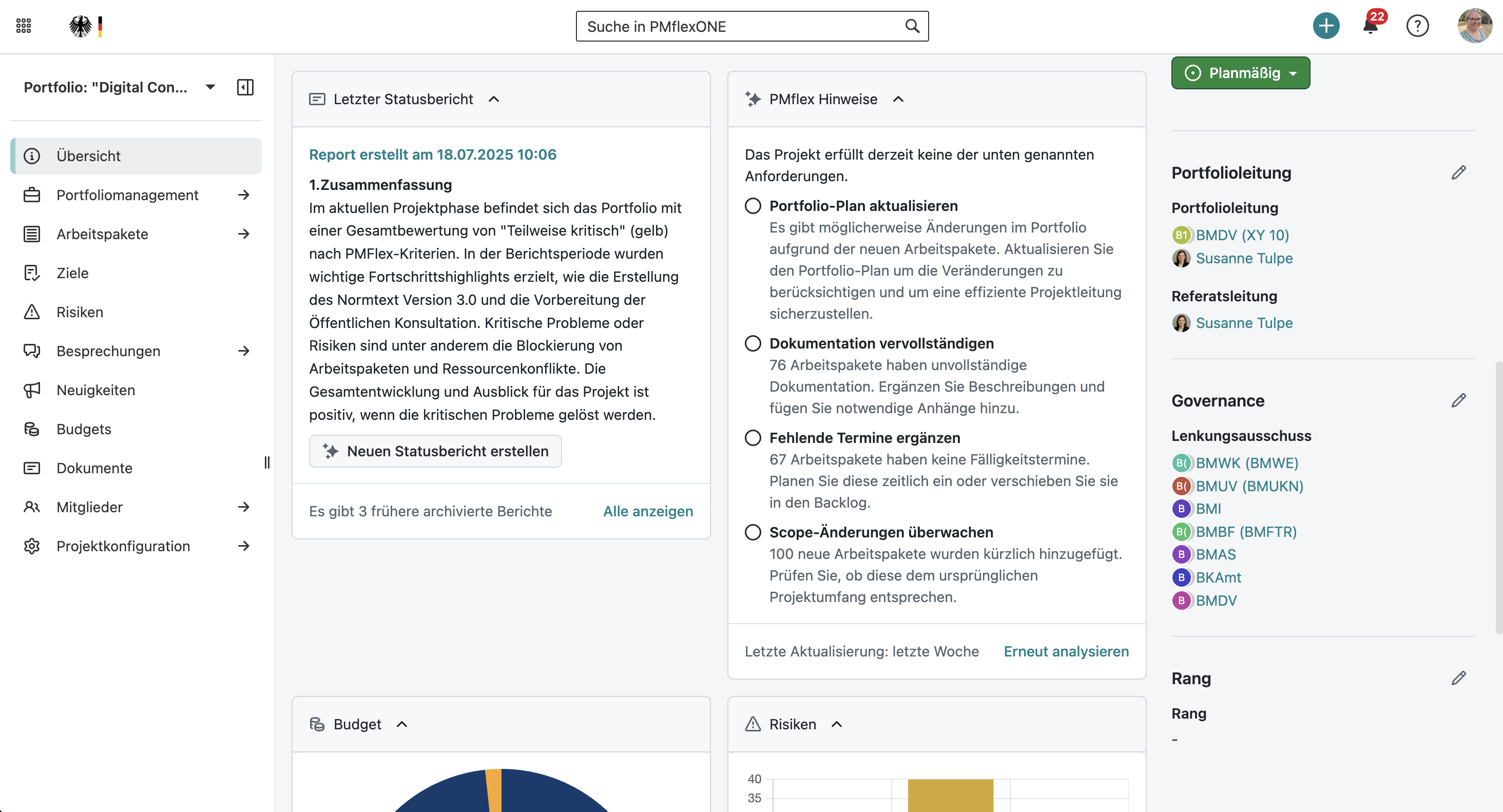
AI support in documents
- Writing tools in the OpenProject editor (translate, rephrase, spell check, generate drafts, etc.)
- Familiar AI editing features directly inside the editor
- The documents module uses the LLM to perform simple text tasks like summarizations
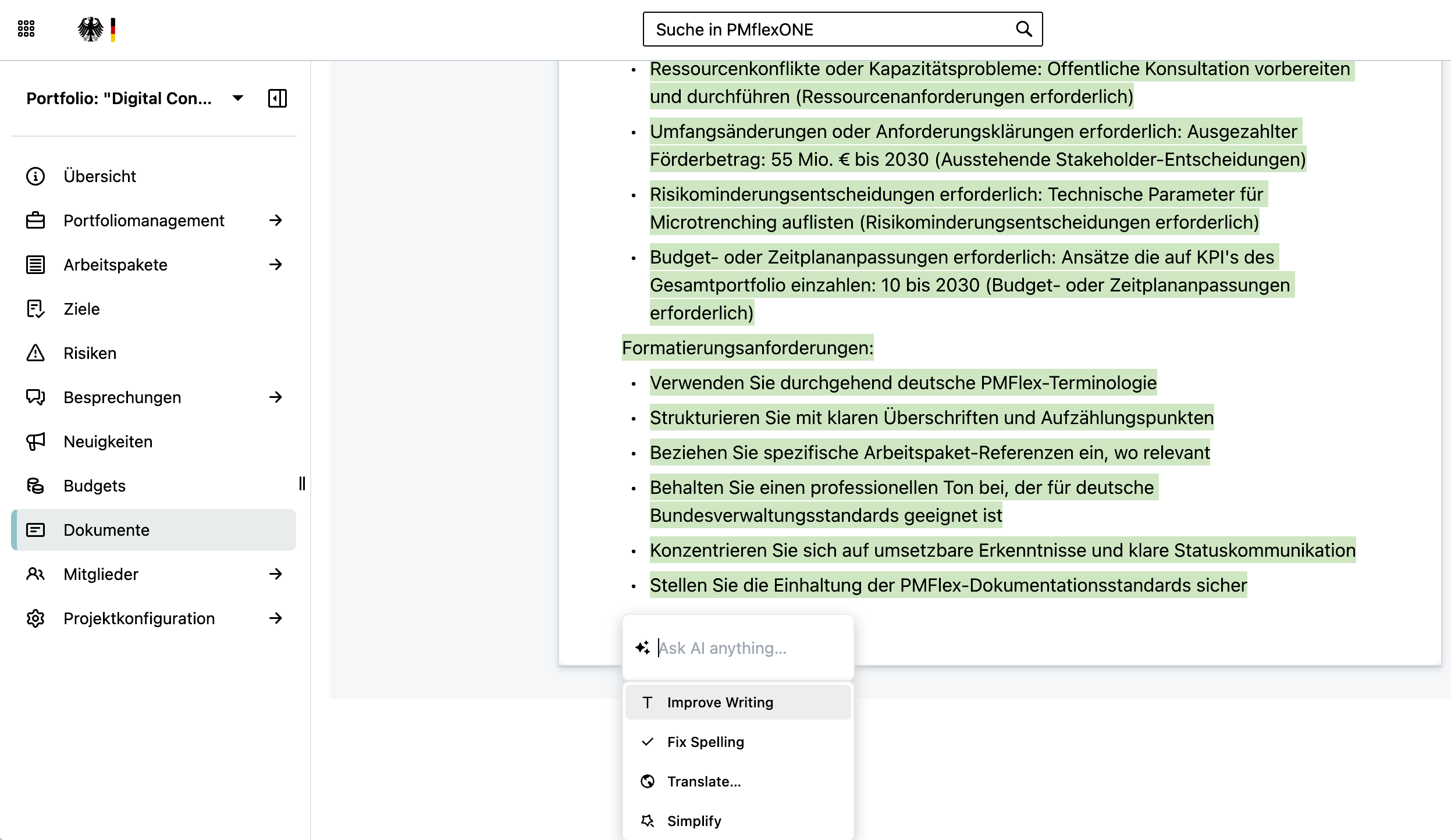
PDF export of portfolio and program status
We believe in a single source of truth for project data. However, there many use cases where an export is extremely helpful, e.g. when information needs to be documented in external systems. So during the hackathon we build an status report engine that creates pixel-perfext pdf files from the data in the system.
- Información de estado
- Presupuesto
- Risks
- Objectives
- KPIs
- Hitos
- Custom attributes
- […]
Kudos go to the German Federal Ministry of the Interior who sponsored the pdf export of work packages in 2023. The pdf export library we developed laid the foundation for this feature.
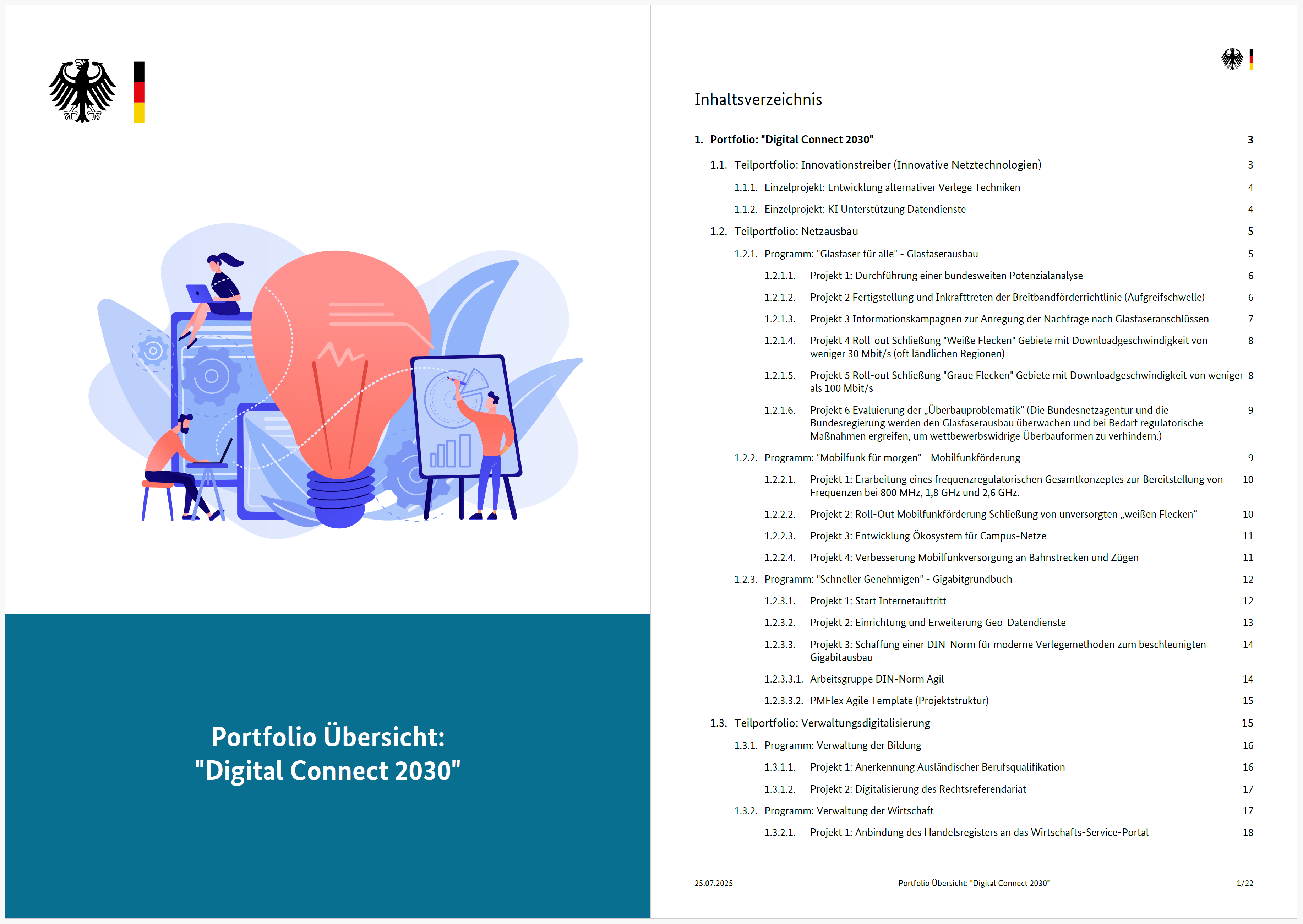
As an outlook we are working on more configuration options to adjust the export to the specific needs. Additionally we plan to add further charts and illustrations.
Found? – What happens after the hackathon?
At the time of writing, it is still open what the next steps will be for OpenProject and the BMDS. What we do know is that the entire OpenProject team has grown through this experience — and we are proud of what was achieved and delivered during the week.
Regardless of the outcome of the tender, we will finalize, thoroughly test, and potentially release the developed features to our customers in future versions.
All released features will be available either in OpenProject itself or in openDesk, the secure office and collaboration suite designed specifically for the public sector.
If OpenProject is selected in the BMDS tender, the rollout would likely proceed as follows:
- Distribution via ZenDiS as a module in openDesk:
- Monthly releases
- Security concepts
- Maintenance
- Soporte
- Alojamiento
- Distribution via ITZBund / Cloudogu
- Implementation consulting via specialized partners such as ]init[
- Demo environments provided through OpenProject’s SaaS infrastructure
Even though the BMDS decision is still pending, this hackathon clearly demonstrated how OpenProject, as an open source solution, can meet the concrete requirements of public administration — quickly, competently, and collaboratively.
There is a visible shift toward data sovereignty, open standards, and independent software solutions — not only, but especially in the public sector. Anyone looking for a future-proof, sovereign solution will find a strong and experienced partner in OpenProject. Learn more about OpenProject for public administration.


